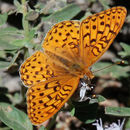Conservation Status
provided by University of Alberta Museums
Not of concern.
- license
- cc-by-nc
- copyright
- University of Alberta Museums
Cyclicity
provided by University of Alberta Museums
One yearly flight peaking in mid July to mid August, depending on altitude and snowpack.
- license
- cc-by-nc
- copyright
- University of Alberta Museums
Distribution
provided by University of Alberta Museums
The core of Hydaspe's distribution is the Pacific Northwest, ranging north to central BC and the mountains of southern Alberta, and south to Colorado and California (Scott 1986). There is an isolated population in the Cypress Hills of Saskatchewan (Layberry et al. 1998), so it should be watched for on the Alberta side of the Hills.
- license
- cc-by-nc
- copyright
- University of Alberta Museums
General Description
provided by University of Alberta Museums
The hindwing underside is diagnostic; no other Speyeria has a maroon-brown underside with creamy-white in place of the usual silvery-white discs. Subspecies rhodope occurs in Alberta (Kondla 2001).
- license
- cc-by-nc
- copyright
- University of Alberta Museums
Habitat
provided by University of Alberta Museums
Most often found near moist subalpine coniferous forests in Alberta.
- license
- cc-by-nc
- copyright
- University of Alberta Museums
Life Cycle
provided by University of Alberta Museums
The mature larvae are black and spiny, and lack pale markings (Guppy and Shepard 2001). In the US, first-instar larvae hibernate without feeding (Scott 1986). This species prefers cool/moist coniferous forests of the mountains to the dry grasslands inhabited by most other Speyeria.
- license
- cc-by-nc
- copyright
- University of Alberta Museums
Trophic Strategy
provided by University of Alberta Museums
The larvae feed on violets (Viola sp.) (Guppy & Shepard 2001), and adults are attracted to yellow composite flowers (Bird et al. 1995).
- license
- cc-by-nc
- copyright
- University of Alberta Museums

